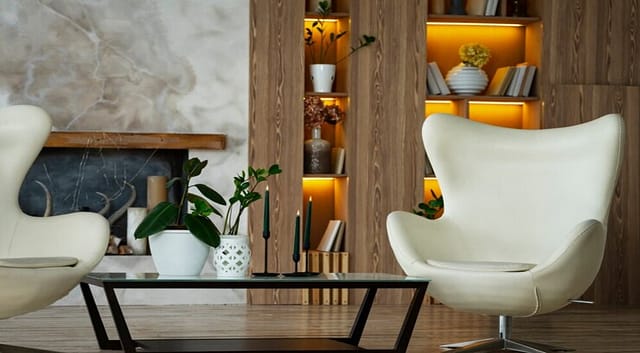
“Life is a canvas; throw all the paint you can at it!”
Interior design is a powerful tool for transforming a house into a home, and one of the most impactful elements of this transformation is the choice of wall paint. The color and texture of your walls set the tone for your entire living space. It’s a medium for self-expression and can profoundly influence the mood and ambiance of your home. In this article, we will explore the world of interior design, focusing on all paint ideas that can help you turn your house into a sanctuary of style and comfort.
Chapter 1: The Power of Color
Color is the cornerstone of interior design. It can evoke emotions, create harmony, and set the stage for your desired atmosphere. When considering wall paint ideas for your home, it’s essential to understand the psychology of color.
1.1. Neutral Tones for Elegance
Neutral colors like beige, gray, and white are timeless choices. They create a sense of serenity and elegance, making your space feel open and uncluttered. They serve as excellent canvases for other decor elements, allowing you to change the mood with colourful accessories and furnishings.
1.2. Bold and Vibrant Hues for Drama
If you’re looking to make a statement, consider bold and vibrant hues like deep red, royal blue, or emerald green. These colors can infuse your space with energy and create a striking focal point. However, use them sparingly to avoid overwhelming the room.
1.3. Pastels for Tranquillity
Pastel shades such as soft pink, mint green, and pale lavender bring a sense of tranquility and relaxation. They are perfect for bedrooms, nurseries, and spaces where you want to promote calmness and serenity.
Chapter 2: Texture and Finish
Choosing the right texture and finish for your wall paint is equally important. Different textures and finishes can add depth and character to your walls.
2.1. Matte Finish for a Subtle Look
Matte finishes are non-reflective and provide a smooth, elegant appearance. They are excellent for hiding imperfections on your walls. This finish is best for bedrooms, living rooms, and other areas where you want to create a relaxed atmosphere.
2.2. Satin and Eggshell for a Soft Glow
Satin and eggshell finishes have a gentle sheen that adds a soft glow to your walls. They are easy to clean and are a popular choice for family rooms, kitchens, and bathrooms.
2.3. Glossy Finish for Drama
Glossy finishes are highly reflective and create a bold, high-impact look. They are perfect for creating drama, but they also highlight imperfections, so be cautious when using them. Consider using glossy finishes for accent walls or in rooms with minimal imperfections.
Chapter 3: Accent Walls
Accent walls are a fantastic way to add personality and style to your space. They create a focal point and can showcase your creativity and unique tastes.
3.1. Striped Patterns
Horizontal or vertical stripes can add visual interest to your room. You can use contrasting colors for a bold look or choose shades from the same color family for a subtle, textured effect.
3.2. Stencils and Murals
Stencils and murals offer endless possibilities for customizing your space. You can create intricate designs or showcase your favourite artwork or motifs.
3.3. Texture on Accent Walls
Consider using textured paints like suede, chalkboard, or metallic for your accent walls. These textures add depth and intrigue, turning a plain wall into a work of art.
Chapter 4: Creating a Flow
While experimenting with different wall paint ideas, it’s essential to maintain a sense of continuity and flow in your home decor.
4.1. Color Palette
Choose a consistent color palette for your home. This doesn’t mean every room should be the same color, but the colors should harmonize with each other. This ensures a cohesive and visually pleasing environment.
4.2. Transitioning Spaces
Use complementary colors or shades from the same color family to create a seamless transition between spaces. This can be achieved through open floor plans or clever wall paint choices that connect adjacent rooms.
4.3. Consider the Lighting
Natural and artificial lighting can significantly affect how paint colors appear. It’s essential to test paint samples in your space under different lighting conditions to ensure the color looks the way you want it to.
Chapter 5: Trends and Styles
Interior design trends evolve over time. Keeping up with these trends can help you create a modern and stylish home.
5.1. Minimalism
Minimalist design emphasizes simplicity, clean lines, and a focus on functionality. It often features a neutral color palette, with accents in bold or contrasting colors.
5.2. Biophilic Design
Biophilic design incorporates natural elements into your home, such as plants, natural materials, and earthy color palettes. It creates a calming and harmonious atmosphere, connecting you with the natural world.
5.3. Industrial Chic
Industrial design takes inspiration from factories and warehouses. Exposed brick, metal, and muted colors are common elements in this style, creating a gritty yet sophisticated look.
In the world of home interior design, wall paint ideas are a key factor in shaping the look and feel of your home. Whether you prefer the timeless elegance of neutral tones, the drama of bold colors, or the tranquillity of pastels, the right wall paint can transform your space. Pairing the right texture and finish with creative accent walls can further enhance your home decor. Remember to maintain a sense of flow and continuity throughout your home, and stay informed about the latest design trends to create a modern and stylish living space. By making thoughtful choices, you can turn your house into a haven of style and comfort, where every wall tells a unique story.

